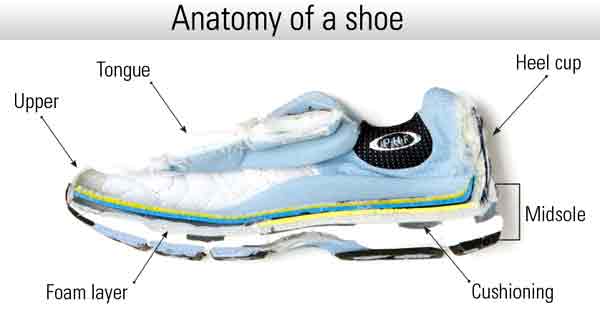Get our independent lab tests, expert reviews and honest advice.
How to buy the best running shoes

Running is one of the simplest sports there is – the only special equipment you really need is a good pair of shoes. Well, it’s simple enough until you get to the store!
On this page:
- How do I find comfortable running shoes?
- Matching shoes to your running style
- How long should running shoes last?
- Which surfaces are suitable for running shoes?
- Can I return running shoes if they don't fit?
- What are running shoes made of?
- Cost
When faced with a dizzying array of styles and brand names, choosing the right pair of running shoes can be a frustrating, not to mention dauntingly pricey, task.
But with the right advice and a bit of pre-emptive, ahem, sole-searching, the key to picking the perfect runners can be a few simple steps away.
How do I find comfortable running shoes?
The right running shoe does several things:
- Cushions the foot: The midsole is the main cushioning layer. Contrary to popular belief, running shoes don’t reduce the force that goes through the body. What they do is increase the time taken for that force to be applied to the body, so there is time to adapt.
- Supports the foot: Shoes can reduce the amount of ‘rolling in’ or rotational movements that occur in the foot during the contact phase of running and walking.
- Feels comfortable: Shoes should feel immediately comfortable out of the box and require no wearing in.
- Fits well: There should be at least 1 to 1.5cm at the end of the shoe, and it should feel snug without being too tight. You should also note the width of the shoe when trying it on, as your foot width may not directly correlate to the shoe length. You may have to buy a larger size if you have wider feet.
- Isn’t too heavy: Walk around and lift your feet from a sitting position. If the shoes feel too heavy, running may be difficult.
Matching shoes to your running style
Your running style will determine what sort of shoe you need. There are several broad classes of shoe type, with features designed to correct or complement different running styles.
- Over-pronator: Most runners pronate at least a little – their foot rolls in after striking the ground, and helps spread the shock of impact. So a little pronation is normal and good. But excessive pronation can cause problems. Depending on the degree to which you pronate, you’ll need either stability or motion-control shoes:
- Under-pronator or supinator: People who underpronate (also referred to as supinators) land on the outside edge of the foot and tend to show excessive wear on the outside edge of the soles of their shoes. This puts a lot of pressure on the leg, so they need neutral shoes with ample cushioning for increased shock absorption.
How long should running shoes last?
Running shoes typically have a very broad lifespan, lasting anywhere from 450km to more than 700km. This is largely dependent on your running style and environment (track versus trail for example).
Australians walk around 3km per day on average, so your shoes should make it through the better part of a year before wear really starts to kick in. Even then, you can probably get a few more months out of them unless you require optimal support or you’re very serious about fitness. However, it’s impossible to know whether the shoes you’re trying on in-store will last a long time.
Which surfaces are suitable for running shoes?
Manufacturers often list the environments suited for their shoes on the box. Examples include:
- All sports
- Everyday wear and running (track/road)
- Endurance training
- Multi-activity athletic training
- Terrain running
This is important to note as running on trails can increase wear rate compared to a track, for example.
Can I return running shoes if they don’t fit?
Almost every manufacturer lets you return shoes within a month or two weeks, if they haven’t been worn. They will only accept worn shoes if they’re faulty or damaged. You cannot return running shoes if you don’t like the colour or they don’t fit properly for example, unless you feel that there’s been a breach of your consumer rights (e.g. the product doesn’t match the advertising).
Things can get a little tricky, even when you do have grounds for a faulty return:
- Some companies specify that they’ll only accept returns on products that arrive faulty.
- Others will accept returns on faulty products, but don’t state whether this extends to shoes that develop faults over time.
- A small number provide a warranty for shoes that develop faults over time. Check company websites so you know exactly what’s covered.
- Some tell you to contact customer service.
- A few don’t provide any information.
As you can see, these are very broad statements that leave a lot of wiggle room in most cases, save for products that are faulty out of the box. Unless specified, err on the safe side and assume that you can’t return shoes once you’ve used them.
What are running shoes made of?

- Upper: The top layer of material that holds your foot to the sole. The material used and the design of the upper are crucial because it can assist in keeping your foot dry and cool. The upper should also be tough and durable, and not tear during normal use.
- Midsole: Between the outer sole and the upper material, the midsole is where the protective foam layer and cushioning is located.
- Medial post: The section built inside the middle or the arch section of the midsole. Most manufacturers make it a contrasting colour to the rest of the sole to indicate that the shoe provides additional support. The bigger and harder it is, the more support it gives against over-pronation.
- Foam layer: The soft feeling you experience when you try on a pair of shoes depends on the quality of the top layer of foam.
- Cushioning: Located in the mid-sole under the foam layer, this is the patented technology that provides cushioning and improves the shoe’s durability. It could be a liquid gel, grid or “wave plate”, depending on the brand.
- Heel counter: The internal “cup” that wraps around your heel. It’s designed to help keep the foot stable and prevent excessive movement within the shoe.
- Tongue: Covers the instep of the foot, protecting it from the laces.
Manufacturers typically make all sorts of claims regarding “breathability,” “orthotic support” or “soft bounce” for example. While we couldn’t test these features and claims, we do suggest taking them with a grain of salt.
Cost
- Most mid-range running shoes ($150 to $200) will provide you with excellent stability and cushioning properties.
- The biggest difference you get by investing in a more expensive shoe is extra durability, thanks to a greater amount of more expensive cushioning material in the midsole of the shoe. These additional midsole components won’t improve the immediate function of the shoe, but they do improve the durability of the cushioning properties.
- Cheaper shoes (under $100) contain cheaper materials, which tend to break down faster.


